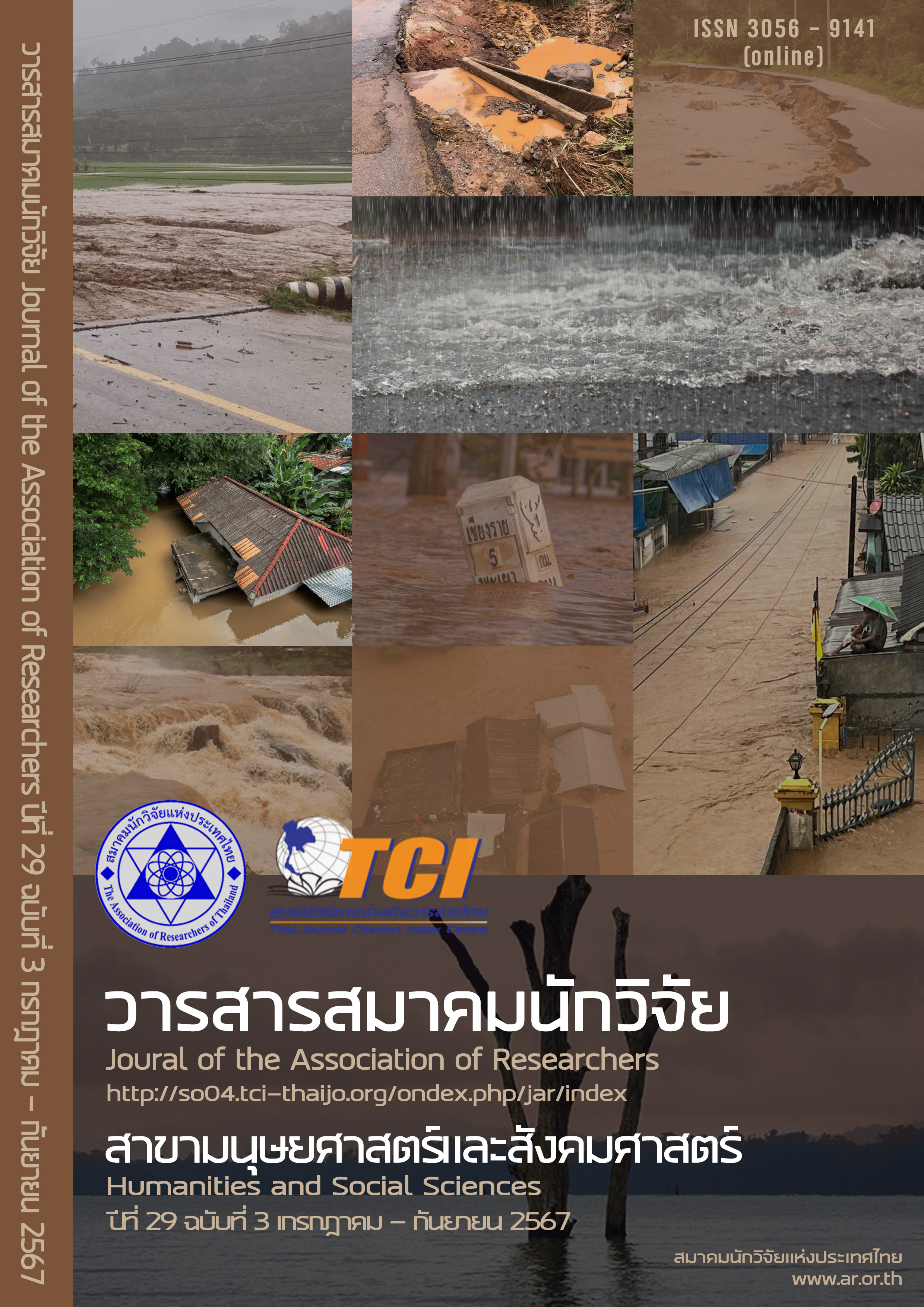The Problem of Students’ Insufficient Participation in the Classroom: Teaching Solution by Content and Language Integrated Learning
Main Article Content
Abstract
A learning management process in the English subject is undoubtedly important to develop students' language skills. Teachers are a distinctly important role to design learning management and find a variety of teaching strategies which are appropriate to develop students' English skills. However, there are still some students who encounter struggling problems in learning English. This is a possible result of those students who have roles of an insufficient learning participation in the classroom, three related problems consisting of 1) teacher-centered teaching, 2) lesson content, and 3) learner autonomy in participating in the classroom. These specific problems can be occurred repeatedly if there is not the clearly learning management process of a teacher. The above problems, nevertheless, can be solved by managing learning with the particular method, Content and Language Integrated Learning (CLIL). This technical teaching emphasizes a dual-focused, such as the target language and course content of the subject. The target language will be used as a tool to teach the subject content according to the subject’s learning objectives. Namely, this method will obviously increase both the learning role and enhance the participation of students. The suitable lessons of CLIL can be applied in any real situations and also give learners the opportunity to have the learner autonomy to learn with their aptitude of individual styles. Therefore, this academic article presents the specific problems of students’ roles of the insufficient learning participation in the classroom and also suggests the unique solutions for those three problems by using Content and Language Integrated Learning.
Article Details

This work is licensed under a Creative Commons Attribution-NonCommercial-NoDerivatives 4.0 International License.
บทความที่ปรากฏในวารสารนี้ เป็นความรับผิดชอบของผู้เขียน ซึ่งสมาคมนักวิจัยไม่จำเป็นต้องเห็นด้วยเสมอไป การนำเสนอผลงานวิจัยและบทความในวารสารนี้ไปเผยแพร่สามารถกระทำได้ โดยระบุแหล่งอ้างอิงจาก "วารสารสมาคมนักวิจัย"
References
ขวัญจิตต์ สุวรรณพรัตน์. (2017). การสอนภาษาอังกฤษและการพัฒนาที่ยั่งยืน:เส้นขนานที่บรรจบกัน. อินทนิล ทักษิณสาร, 12(3). 141-159.
ธณพร โปมิน และ ประดิษฐ์ ศรีโนนยาง. (2563). การพัฒนาระดับความสามารถทางภาษาอังกฤษของนักศึกษา ระดับปริญญาตรีตามกรอบอ้างอิงความสามารถทางภาษาของสหภาพยุโรปด้วยการประยุกต์ใช้วิธีการสอนผ่านเว็บ. วารสารพัฒนาการเรียนรู้ใหม่, 5(5) 212-223.
ธมลวรรณ ธีระบัญชร. (2023). การจัดการเรียนรู้ด้วยเทคนิคการสอนร่วมสมัย. วารสารสังคมศาสตร์ มหาวิทยาลัยมหามงกุฎราชวิทยาลัย, 6(1). 182-201.
นิตยา สงวนงาม. (2020). ปัจจัยที่ส่งผลต่อความล้มเหลวของการศึกษาไทยที่ไม่สามารถพัฒนาผู้เรียนสำหรับทักษะ แห่งศตวรรษที่ 21. วารสารวิจัยราชภัฏเชียงใหม่, 21(2). 1-9.
Andriani, F., P., Padmadewi, N., N., & Budasi, G., I. (2018). Promoting autonomous learning in English through the implementation of content and language integrated learning (CLIL) in science and Maths subjects. SHS Web of Conferences, 42. 1-6. https://doi:10.1051/shsconf/20184200074.
Arsairach, S. (2550). The analysis and evaluation of English textbooks for prathomsuksa 4. [Master’s thesis, Silpakorn University]. http://www.thapra.lib.su.ac.th/objects/thesis/fulltext/snamcn/Suphannee_Arsairach/Fullt ext.pdf.
Bermeo, B., J. & Auquilla, O., D. (2019). Effects of the CLIL approach in oral production of English students in the second year of the united general baccalaureate at a high school in Cuenca, Ecuador. Revista Boletin Redope, 8(12), 117-128.
Çelik, F., & Yangin, E., C. (2022). The use of augmented reality in a gamified CLIL lesson and students’ achievements and attitudes: A quasi-experimental study. Smart Learn. Environ, 9(30), 1-18.
Chung, Ji. (2021). “We Participate, Silently”: Explicating Thai University Students’ Perceptions of Their Classroom Participation and Communication. Qualitative Research in Education, 10 (1). 62-87.
Delgado, M. A. C., Delgado, M. Ángel C., Loor, J. P. F., Valle, E. J. H. D., & Castro, A. A. O. (2023). Learning styles applied to teaching the English language. Macrolinguistics and Microlinguistics, 3(1/2) 53–60.
Fajardo, D, T., Argudo, J., & Abad, M. (2020). Language and teaching methodology features of CLIL in university classrooms: A research synthesis. Colombian Applied Linguistics Journal, 22 (1), 40-54.
Graham, K. M., Mathews, S. D., & Eslami, Z. R. (2020). Using children’s literature to teach the 4Cs of CLIL: A systematic review of EFL studies. Latin American Journal of Content & Language Integrated Learning, 13(2), 163–189.
Hussain, S., S. (2022). Content and language integrated learning (CLIL) in ELT as a link between language learning and content development. Arab World English Journal (AWEJ), 13(2). 386-400.
Hussien, Q., R. (2020). The effectiveness of integrating CLIL principles in a conversation course at the university of Sulaimani, Journal of University of Garmian, 7(1), 256-255.
Ningrum, R., D., Listiani, I., & Kartikasari, M. (2023). CLIL approach to the students’ foreign- language communication skills: Teacher’s perception. KnE Social Sciences, 8(7), 69–74.
Nilplub, C. (2021). Development of student engagement in higher education: a case study of Thai public university. Proceedings of 13th International Conference on Humanities and Social Sciences 268-275. https://www.researchgate.net/profile/Chartaya-
Nilplub/publication/353917567_Development_of_Student_Engagement_in_Higher_Education_A_Case_Study_of_Thai_Public_University/links/61193079169a1a01030139cf/Development-of-Student-Engagement-in-Higher-Education-A-Case-Study-of-Thai-Public- University.pdf.
Rodríguez, C., C., & Prat, F., B. (2022). Cooperative learning in the CLIL classroom: Challenges perceived by teachers and recommendations for primary education. Educatio Siglo XXI, 40(1). 79-106.
Scheb, B., P. (2019). University students' perception on autonomous learning: A case of private university, Thailand.[Paper presentation] The 1st International Conference on English Studies: Innovation in English Language Teaching and Learning Conference: The ICES 2018, Krabi, Thailand.
Sessoms, J. (2018). Exploring the culture gap between Western student centered learning and traditional Thai education. Proceedings of 14th International Conference on Humanities and Social Sciences 66-67. https://hs.kku.ac.th/ichuso/2018/ICHUSO-030.pdf.
Tagin, L., & Ríordáin, M. N. (2021). Building science through questions in content and language integrated learning (CLIL) classrooms. International Journal of STEM Education, 8, 1-14.
Vela-Rodrigo, A. A. (2022). CLIL for the teaching of history and English in secondary education: How to complete the existing materials. Language Value, 15(1), 1-29.
Ventura, R., L. (2021). Effects of CLIL on the students’ motivation and learning of English as a foreign language. Retrieved from http://repositori.uvic.cat/bitstream/handle/10854/6859/trealu_a2021_riera_laura_effects_clil_motivation.pdf?sequence=1&isAllowed=y
Translated Thai References
Pomin, T., & Srinonyang, P. (2563). Applying web-based instruction to EFL for undergraduate students to improve the English language ability based on the reference levels of the common European framework of reference for languages. Journal of Modern Learning Development, 5(5). 212-223.
Sanguanngarm, N. (2020). Factors affecting the failure of Thai education to equip Thai students with 21st century skills. Rajabhat Chiang Mai Research Journal, 21(2). 1-9.
Suawannoppharat, K. (2017). English language teaching and sustainable development: Paradox of convergence. Inthanithaksin Journal, 12(3). 141-159.
Theerabunchorn, T. (2023). Contemporary teaching techniques learning management. Journal of Social Sciences Mahamakut Buddhist University, 6(1). 182-201.


